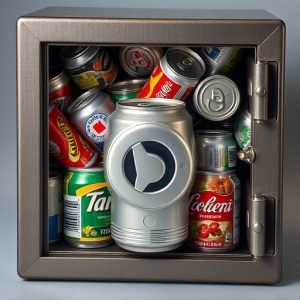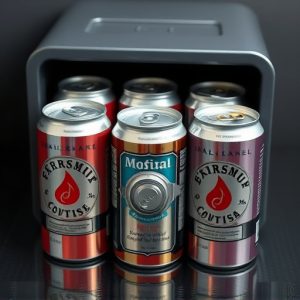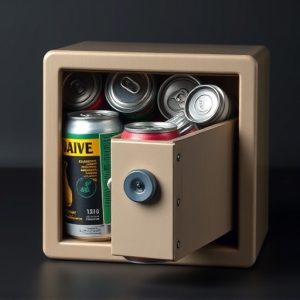Stealth Safes: Disguised in Everyday Products, Like a Fake Cleaning Compartment
In today's digital era, disguised safe designs offer an innovative solution for securing valuab…….
In today's digital era, disguised safe designs offer an innovative solution for securing valuables with a focus on privacy and convenience. Integrated into everyday products like fake cleaning supplies, these safes provide a discrete way to store sensitive materials or keep possessions secure without drawing attention. The "Fake Cleaning Product Secret Compartment" is a revolutionary stealth safe design that turns ordinary cleaning product packaging into a secure hiding place for valuable items or documents. This seamless blend of security and aesthetics caters to individuals seeking peace of mind, especially in high-risk areas. While challenges include balancing functionality and deception, water-resistant materials and clever engineering ensure the safety of contents without compromising the product's appearance.
In today’s digital era, security and discretion are paramount. This is where stealth safe designs, disguised as everyday products, step in as innovative solutions. Understanding the concept behind these hidden compartments, such as the popular “fake cleaning product secret compartment,” opens up a world of possibilities for secure storage and discreet transportation. This article explores why disguised safe designs are gaining traction, delves into a case study on a fake cleaning product secret compartment, and examines the integration and challenges of stealth safes within everyday products.
- Understanding the Concept: Why Disguised Safe Designs?
- The Fake Cleaning Product Secret Compartment: A Case Study
- Integrating Stealth Safes into Everyday Products: Possibilities and Challenges
Understanding the Concept: Why Disguised Safe Designs?
In today’s digital age, where security and privacy are paramount concerns, disguised safe designs offer an innovative solution for securing valuable items. The concept behind these stealthy safes is to seamlessly integrate them into everyday products we already use, creating a hidden compartment that can store sensitive materials or keep possessions secure without drawing attention. This approach leverages the fact that many people feel safer keeping their valuables hidden within familiar household objects.
Disguised safe designs, such as a fake cleaning product with a secret compartment, provide an effective way to protect personal documents, jewelry, or even financial records from prying eyes. By appearing unassuming and blending into everyday routines, these safes offer convenience and peace of mind for their owners. This unique approach to security is especially appealing for those living in areas where home invasions are a concern or for individuals seeking discreet ways to safeguard their assets.
The Fake Cleaning Product Secret Compartment: A Case Study
In the realm of innovative stealth safe designs, a unique concept has emerged—the “Fake Cleaning Product Secret Compartment.” This ingenious idea turns an everyday household item into a secure hiding place for valuable items or sensitive documents. By disguising the compartment as an ordinary cleaning product, it seamlessly integrates into any home or office environment, remaining virtually undetectable.
A case study of this design reveals its meticulous attention to detail. The exterior of the container mimics the packaging of popular cleaning products, complete with labels and branding. Once activated, a subtle mechanism allows access to a hidden compartment inside, providing a safe space for anything from cash and passports to precious jewelry. This versatile design offers a creative solution for individuals seeking discreet storage options without compromising on aesthetics or functionality.
Integrating Stealth Safes into Everyday Products: Possibilities and Challenges
Integrating stealth safes into everyday products presents a fascinating blend of design possibilities and challenges. One intriguing concept is to embed secure storage compartments within seemingly ordinary items, such as fake cleaning product bottles or kitchen utensils. This approach offers discrete protection for valuables, ensuring they remain hidden from prying eyes. For instance, a sleek spray bottle designed to look like a common household cleaner could secretly harbor a safe compartment for small personal items like keys, cash, or even a backup phone.
However, implementing such solutions comes with its hurdles. Designers must strike a delicate balance between functionality and deception, ensuring the integrated safe remains accessible yet virtually undetectable. Additionally, material choices and construction techniques play vital roles in achieving both stealth and durability. Water-resistant materials and clever engineering can help safeguard contents from environmental elements while maintaining the product’s aesthetic appeal.
Stealth safe disguised everyday product design offers a fascinating blend of functionality and secrecy. As demonstrated by the success of the fake cleaning product secret compartment, integrating hidden safes into seemingly innocuous items presents a compelling solution for secure storage and enhanced privacy. While challenges remain in terms of design integration and material sustainability, the potential for stealth safes to revolutionize personal security and discretion in daily life is undeniable. This innovative approach encourages us to rethink ordinary objects as potential havens for safeguarding valuables, making our spaces safer and more secure.


